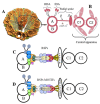The eukaryotic flagellum makes the day: novel and unforeseen roles uncovered after post-genomics and proteomics data
- PMID: 22708495
- PMCID: PMC3499766
- DOI: 10.2174/138920312803582951
The eukaryotic flagellum makes the day: novel and unforeseen roles uncovered after post-genomics and proteomics data
Abstract
This review will summarize and discuss the current biological understanding of the motile eukaryotic flagellum, as posed out by recent advances enabled by post-genomics and proteomics approaches. The organelle, which is crucial for motility, survival, differentiation, reproduction, division and feeding, among other activities, of many eukaryotes, is a great example of a natural nanomachine assembled mostly by proteins (around 350-650 of them) that have been conserved throughout eukaryotic evolution. Flagellar proteins are discussed in terms of their arrangement on to the axoneme, the canonical "9+2" microtubule pattern, and also motor and sensorial elements that have been detected by recent proteomic analyses in organisms such as Chlamydomonas reinhardtii, sea urchin, and trypanosomatids. Such findings can be remarkably matched up to important discoveries in vertebrate and mammalian types as diverse as sperm cells, ciliated kidney epithelia, respiratory and oviductal cilia, and neuro-epithelia, among others. Here we will focus on some exciting work regarding eukaryotic flagellar proteins, particularly using the flagellar proteome of C. reinhardtii as a reference map for exploring motility in function, dysfunction and pathogenic flagellates. The reference map for the eukaryotic flagellar proteome consists of 652 proteins that include known structural and intraflagellar transport (IFT) proteins, less wellcharacterized signal transduction proteins and flagellar associated proteins (FAPs), besides almost two hundred unannotated conserved proteins, which lately have been the subject of intense investigation and of our present examination.
Figures




References
-
- Lewin RA. Studies on the Flagella of Algae. II. Formation of Flagella by Chlamydomonas in Light and Darkness. Annals New York Acad. Sciences. 1953;56:1091–1093. - PubMed
-
- Lewin RA. Mutants of Chlamydomonas moewusii with impaired motility. J. Gen. Microbiol. 1954;11:358–363. - PubMed
-
- Gibbons IR, Rowe AJ. Dynein: a protein with adenosine triphosphatase activity from cilia. Science. 1965;149:424–426. - PubMed
Publication types
MeSH terms
Substances
LinkOut - more resources
Full Text Sources
Other Literature Sources
Miscellaneous
